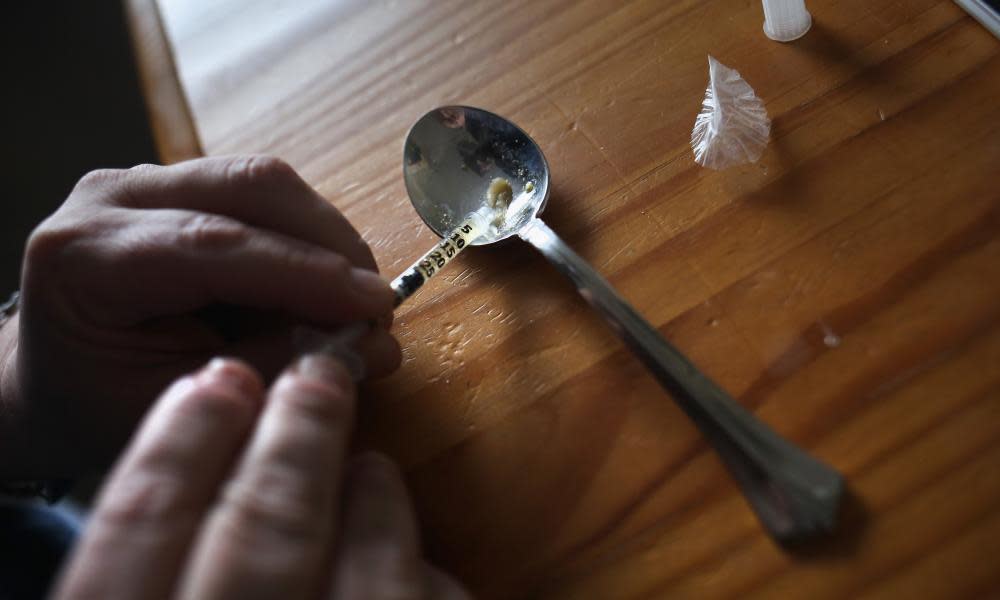US heroin use has increased almost fivefold in a decade, study shows

Heroin use among American adults has increased almost fivefold in the last decade, according to a study based on a survey of almost 80,000 people.
Researchers found that just after the turn of the millennium, 0.33% of the adult population reported having used heroin at some point in their life, but 10 years later it had risen to 1.6% – a figure corresponding to about 3.8m Americans.
“There are more people in the US using heroin, there are more people that meet criteria for heroin addiction, and we are seeing increases in all different social strata, in different age groups, in both sexes,” said Silvia Martins, lead author of the research from Columbia University Mailman School of Public Health.
While the boom in heroin use is widespread, the study reveals that the rise is steeper for particular groups. Among them, white individuals showed a greater increase than non-white, with an almost six-fold increase in heroin use, rising from 0.34% to 1.9% over the decade.
The study also highlights the link between misuse of prescription opioids and heroin abuse.
“It is already well established that after prescription opioids became widely available as prescription drugs in the US in the early 90s, we see an increase in prescription opioid misuse,” said Martins. “People that misuse prescription opioids are more likely to transition to initiate heroin use than people that have never used [them],” she adds.
The growing epidemic of prescription opioid and heroin abuse in the US is a crisis that has alarmed politicians, healthcare providers and the public alike. According to recent figures, 91 Americans die every day from an opioid-related overdose, with a recent report revealing that deaths from heroin-related overdoses almost quadrupled between 2002 and 2013.
While the latest research does not unpick the cause of the rise in heroin use, the authors point to multiple factors, including recent policies designed to crack down on overprescription of opioids and their misuse.
“Once you don’t get access to that medication via the ‘legal’ market, you end up going to the illegal market and street heroin in several areas of the US is very cheap,” said Martins.
Writing in the journal Jama Psychiatry, Martins and colleagues describe the analysis of data from two national US surveys, one of which was carried out from 2001-2 involving about 43,000 adults, while the other was carried out from 2012-13 and involved just over 36,300 adults.
Among the questions, the survey probed whether participants had ever used heroin, whether that use was in the last year, and how frequently they used it, as well as asking questions about whether they had misused opioid-containing prescriptions. Participants were also assessed for symptoms of heroin abuse or dependency.
Analysis revealed that heroin use has increased across all age groups in the last decade. The figures, the authors say, correspond to around 3.8 million American adults having used heroin at some point in their life, although they add that the figure is probably even higher, since the surveys did not take into account homeless individuals or those in prison – groups both known to have higher levels of substance abuse than the general population.
The study also reveals that the proportion of adults who have ever had a heroin use disorder or dependence has more than tripled over the decade, rising from 0.21% to 0.69%. Among heroin users, however, there has been a drop in abuse. “Nowadays we are seeing more casual heroin users,” said Martins.
The research shows that both heroin use and heroin dependence or abuse showed a steeper rise for adults who were male, white, not married, had a lower education or a lower income. Furthermore, adults under the age of 45 showed a greater increase in heroin abuse or dependence than older adults.
When looking at whether taking opioid prescriptions for non-medical purposes leads to heroin use, the team found that among non-whites, the proportion of adults misusing opioid prescriptions before they began using heroin fell between the two surveys. But among whites, the figure rose from 35.8% to 52.8%.
That, says Martins, reflects historic access to opioids. “When prescription opioids started becoming widely available in the US a lot of physicians wouldn’t prescribe them for non-whites” said Martins. That, she says, has had a knock on effect when it comes to heroin use. “If you don’t have access to a certain drug for medical purposes you are less prone to use it for non medical purposes and then you are less prone to use another drug that might be related to [it].”
However the authors add that the proportion of adults using heroin rose for all frequencies of prescription opioid misuse, and for those with no previous history of other drug use, suggesting there are multiple factors behind the growing heroin epidemic.
Martins said that the study reflects the need for better training among medical professionals including the use of recent guidelines published by the CDC on the prescription of opioids. Assessment of prescription drug monitoring programmes, education about addiction treatments, and expansion of medication-based treatments for addiction, are also important she adds.
Gary Mendell, founder and CEO of Shatterproof, a national US non-profit organisation focused on addiction, agreed.
“Every day that our healthcare system does not follow what science has proven to be the right protocols for prescribing opioids and/or treating those who are addicted to opioids we are unnecessarily losing our loved ones,” he said. “This is a human tragedy that is completely preventable.”

 Yahoo News
Yahoo News 
